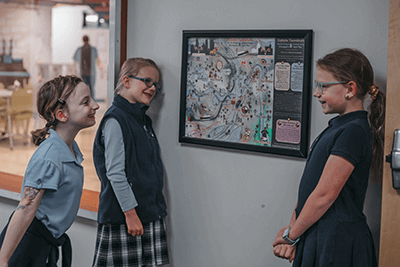October 10, 2024
 from Dr. Bill Hudson, head of school
from Dr. Bill Hudson, head of school
“Makhoche kin de dakhota thamakhoche.” (Maw-ko-chay keen day dah-ko-tah tah-mah-ko-chay) This is the land of the friendly people, the Dakota.
You may be noticing the school calendar over the next week or so is a bit wonky. This is true for several different reasons, including parent-teacher conferences and the long-standing tradition of taking “MEA days” as a fall break. This year, we are also commemorating Indigenous Peoples Day on Monday, October 14.
As we recognize Indigenous Peoples Day on Monday, we have a unique opportunity to reflect on the profound impact that Native cultures, histories, and contributions have had—and continue to have—on our country. This day calls on us to honor the rich heritage of Indigenous peoples while also acknowledging the struggles they have faced throughout history.
Mounds Park Academy acknowledges the language and history of the Wahpekute and the larger Očhéthi Šakówin nation and its connection to these cultures through the land on which the school resides. Mounds Park Academy acknowledges that our school rests on Dakota homeland and that Indigenous Peoples have the longest relationship to this land.
At Mounds Park Academy, our commitment to fostering empathy, respect, and global citizenship is deeply aligned with the values behind Indigenous Peoples Day. Through thoughtful discussion and learning, we aim to provide our students with the tools to engage critically with the complexities of our shared history.
For instance, in Lower School art students have started an art history timeline beginning with prehistoric art. While learning about symbols used in early petroglyphs that have been discovered around the world, students discuss how our brains are wired to read images and how similar images have been discovered around the world. A connection is made between the prehistoric art from around the world and the Jeffers Petroglyphs in Minnesota by ancestors of present-day Minnesota native peoples. In second grade, students create their own symbols in carved-in clay tiles that they have created.
The name of our school comes from Indian Mounds Regional Park and the surrounding Mounds Park neighborhood. The original location of the school in 1982 was intended to be in a St. Paul public school in the neighborhood. At the last moment, the purchase of the building fell through, but the name was kept as marketing materials had already been published.
Created in 1892, the park sits high on a bluff above the Mississippi River. The landscape of Indian Mounds is a sacred place of burial. It is a cemetery built by the ancestors of living people. The place has deep significance to the Upper Sioux Community, Lower Sioux Community, Shakopee Mdewakanton Sioux Community, Prairie Island Indian Community, Ho-Chunk Nation of Wisconsin, Iowa Tribe of Kansas and Nebraska, Sisseton-Wahpeton Oyate, and other descendants of those who are buried there. It is home to the only known remaining burial mounds within the Minneapolis-Saint Paul urban core.
Indigenous Peoples Day also serves as an important reminder of the role we all play in building a more just and equitable society. It is vital that we continue to engage in open conversations about history, inclusion, and the need for greater cultural awareness. By embracing these conversations, we empower our students to be leaders in creating positive change and advocating for equity and justice in all areas of life.
Addressing current events, holding courageous conversations, making connections, and weaving together information from across different subject areas is creating knowledge. Engaging in conversations to understand the perspectives of others and having the humility to challenge our assumptions is how we will make sense of a constantly changing world. And being willing to change our minds and hearts is how we will create a just and peaceful world. That is what “Dream Big. Do Right.” is all about.
As we observe Indigenous Peoples Day, I encourage you to join your children in reflecting on what this day means to our community and our broader society. Together, we can nurture a deeper understanding of the significance of this day, and, more importantly, inspire action that honors the diverse voices and contributions that have shaped—and continue to shape—our world.
Thank you for your ongoing partnership and for fostering an inclusive, supportive environment both at home and within the MPA community.